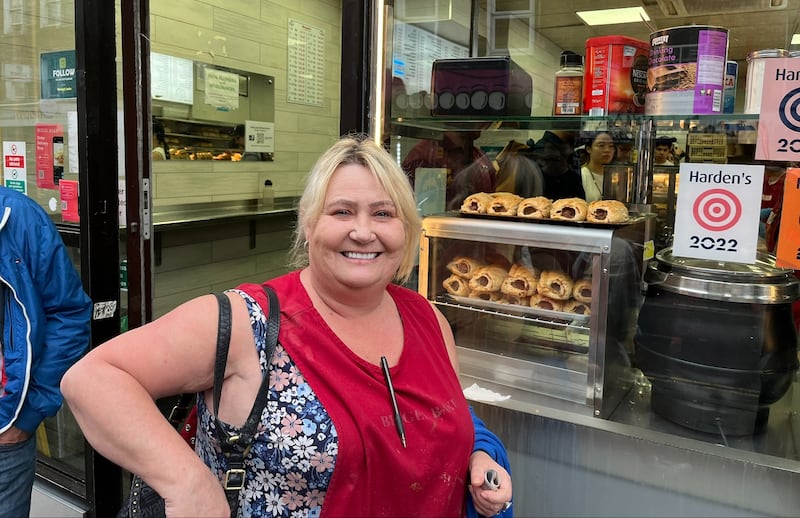There are few constants on Brick Lane, a cacophonous, chaotic and wildly diverse market street in London’s East End that runs south from Shoreditch. But the beigel shop queues are always there.
Walk to the top of Brick Lane at any time of the day or night, and you are virtually guaranteed to see lines of people snaking out of a pair of adjacent shopfronts. Beigel Bake in number 159, better known to locals as the “white one”, and the Beigel Shop a couple of doors down, known as the “yellow one”, are London culinary and social institutions.
Their rivalry is storied, their humble fare famous. Madonna is said to be among their celebrity fans, as were the Spice Girls in their heyday. When Prince William wanted to see how East End businesses were coping at the height of the pandemic, it was to Beigel Bake that he ventured.
Twenty-four hours a day, seven days a week, these two little bakeries stay open like fast food chapels, feeding London’s huddled masses of locals and tourists. The pressed-for-time and the curious, the peckish and the drunk, they all end up congregating outside Brick Lane’s famous beigel outlets.
READ MORE
Yet Beigel Bake and the Beigel Shop – two long-standing Jewish businesses on Bangladeshi London’s main thoroughfare, which now also rubs up against London’s hipster tech core – are also monuments to the city’s diversity and the waves of immigration that have defined surrounding streets.
Brick Lane is part of an old working class neighbourhood that is now one of the trendiest parts of London, although it retains its scruffy, arty edge. It was once a bastion of Irish and Jewish immigrants, before people from Bangladesh started to settle around the area in the early 1950s.
The street is now known as “curry mile” due to the number of outlets serving Asian cuisine. Yet it is still as famous for its beigels as its bhajis.
The yellow one at number 155 was the first of the two Jewish bakeries on Brick Lane. It was opened in the early 1960s by an Israeli, Jonny Cohen, who owned several others in the East End. His brother, Asher Cohen, soon joined him from Israel to run the business.
Family businesses often splinter and by the early 1970s, Asher had decided to go his own way. He teamed up with his other brothers, Amnon and Jimmy, to open a rival bakery at number 159, where now stands the white one. A rivalry was born.
The yellow one has changed hands a few times since and is now controlled by investors including two young brothers from the Zelman family. The white one, however, has remained in Cohen family hands, and is run by the sons of its founders.
Both are famous for their beigels stuffed with salt beef (known in Ireland as corned beef). The yellow one also specialises in sweet baked goods, while the white one is seen as possibly “more Jewish” – it still eschews bacon as an ingredient, for example, while you can get a bacon beigel in the yellow one.
Last Friday afternoon, when the queues had died down a bit, I landed at the white one. Eli Cohen, the son of Amnon, was overseeing proceedings in the bakery, which pumps out more than 3,000 beigels per day (Jewish beigels are boiled and baked to make them chewier than their US bagel cousins). The counter was staffed by the no-nonsense East End women for which the white one is renowned.
I ordered a salt beef and gherkin beigel from one of the women, whose accent caught my ear. “Is she Irish?” I asked Eli.
“Too right she is,” he replied. “I don’t know where from. Go and ask her.”

The woman got there first. “Where are you from?” she enquired. I told her Wicklow, but that my family home is near Crumlin in Dublin. What followed was a typically Irish scene that appeared to delight those queuing at the counter and the staff, who were all listening in.
“Crumlin?” she exclaimed. “I’m from Crumlin. What street?” I told her.
“That’s only around the corner from me,” she said, her Dublin accent thickening by the second.
The woman, Lavinia McMahon, said she has been living in London for 37 years and working at the bakery for 25 of them.
“That’s my aunt. She’s here even longer,” she said, pointing to another woman in the shop. Aunt Bernadette has been in London for 40 years. Yet it still took only a few seconds for her accent to switch from a London lilt to a Dublin brogue.
[ Irish in London in 2022: A vibrant new generation amid an ageing populationOpens in new window ]
As Lavinia had finished her shift, we all had a grand old chat outside about being Irish in London, while I grappled with my food. Lavinia said the bakeries are never quiet. The queues never end. “It never changes. Nobody really knows why.”
As I wolfed down my salt beef beigel, I felt as if perhaps I had an idea why. Then I popped next door to the yellow one for a pistachio tart. As full as a tick for less than £10 (€11.60), I headed back into central London, and then home.
















